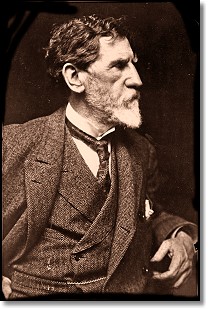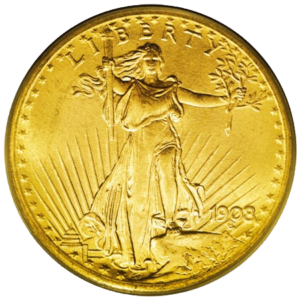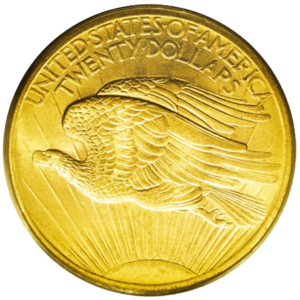$20 Saint Gaudens
The first Saint-Gaudens double eagles, acclaimed as one of the most beautiful and artistic U.S. coin designs, did not display the motto IN GOD WE TRUST anywhere on the coin. Even though the Coinage Act of 1890 did not include that motto in the list of required wording to be placed on U.S. coins, perhaps an unintended omission, both Congress and the public nevertheless wanted it there.
 The motto was restored (it was on the previous Liberty Head type) later in 1908 by Congressional action, which brought the double eagle into compliance with the Act of March 3, 1865, the original mandate for the text. There was one more significant modification of the double eagle before President Franklin Delano Roosevelt ended circulating gold coinage in 1933. In 1912 the number of stars encircling Liberty on the obverse was increased from 46 to 48, marking the addition of New Mexico and Arizona to the Union. Most double eagles minted after 1928 were stored by the Treasury, not released into circulation.
The motto was restored (it was on the previous Liberty Head type) later in 1908 by Congressional action, which brought the double eagle into compliance with the Act of March 3, 1865, the original mandate for the text. There was one more significant modification of the double eagle before President Franklin Delano Roosevelt ended circulating gold coinage in 1933. In 1912 the number of stars encircling Liberty on the obverse was increased from 46 to 48, marking the addition of New Mexico and Arizona to the Union. Most double eagles minted after 1928 were stored by the Treasury, not released into circulation.
Roosevelt’s Executive Order 6102 of April 5, 1933, stated: “I, Franklin D. Roosevelt, President of the United States of America É do hereby prohibit the hoarding of gold coin, gold bullion, and gold certificates within the continental United States by individuals, partnerships, associations and corporations ”
Individuals were ordered to deliver gold coins, bullion, and gold certificates to a Federal Reserve bank or branch by May 1 of that year. Exceptions were made for jewelers, artists, and collectors of “rare and unusual” gold coins, but the Order also allowed “any one person” to keep “gold coin and gold certificates in an amount not exceeding in the aggregate $100.00.”
Though not explicit in the wording, the Order nonetheless effectively ended the legal tender status, thus circulation, of gold coins in this country. Confiscation and subsequent melting destroyed the majority of the later 1920s and all 1930s double eagles. Many of today’s survivors came from stockpiles held in foreign banks, who had no interest in returning gold coins to the U.S. for melting. These expatriate coins returned to the U.S. starting in the 1940s, following increased demand caused by the growing popularity of collecting double eagles.
Of the destroyed pieces, the 1933 double eagle has an especially storied history. Two examples were placed in the Smithsonian in 1934, but of the nearly one half million double eagles minted starting in March 1933, nearly all were melted. The Mint has an established position that none of the coins were officially released into circulation, thus making illegal any private ownership of a 1933 double eagle. However, some (perhaps 20 or more) of the double eagles managed to leave the Mint under circumstances that are murky. Several of the coins sold under private transactions in the 1940s were subsequently seized or turned over to federal agents. The most famous was owned by King Farouk of Egypt; his 1933 example travelled a mysterious path following his 1952 overthrow, ending in a 2001 court decision, which resulted in that example being officially issued and monetized by the Treasury.
Subsequently sold in July 2002 to an anonymous bidder for a record $7,590,020.00 (the $20 required by the act of monetization), half of the proceeds went to the U.S. government, the other half to the British coin dealer who had possessed the Farouk coin (though provenance was not established). Additional coins have recently surfaced, all of which were seized by the U.S. government after being submitted to the Mint for authentication; ownership of those pieces is currently being litigated. There is speculation that more 1933 double eagles exist, but if so they are unlikely to be publicly announced unless the courts legitimize private ownership. Though production of circulating double eagles ended in the early 1930s, the Saint-Gaudens obverse design was reused by the U.S. Mint for gold bullion coins, authorized by the Gold Bullion Coin Act of 1985, and first issued in 1986.
 The obverse features a full-length image of Liberty, facing forward with an olive branch in her extended left hand and a raised torch in her extended right hand. Draped in a long, flowing gown, her hair is swept to the left. Some describe her as striding forward, but she appears instead to be in a pose; the foot of her left leg rests on a large rock (in front of which are oak leaves), difficult terrain through which to be walking. To Liberty’s right, at the bottom of the coin, the sun is visible behind a depiction of the U.S. Capitol building. Rays from the sun extend upward from behind the Capitol and Liberty to about the level of Liberty’s waist. At the top of the coin is the word LIBERTY, the torch separating I and B. Forty-six tiny six-point stars (48 stars from 1912 forward) are arrayed just inside the flat rim, forming a circle broken only at the bottom.
The obverse features a full-length image of Liberty, facing forward with an olive branch in her extended left hand and a raised torch in her extended right hand. Draped in a long, flowing gown, her hair is swept to the left. Some describe her as striding forward, but she appears instead to be in a pose; the foot of her left leg rests on a large rock (in front of which are oak leaves), difficult terrain through which to be walking. To Liberty’s right, at the bottom of the coin, the sun is visible behind a depiction of the U.S. Capitol building. Rays from the sun extend upward from behind the Capitol and Liberty to about the level of Liberty’s waist. At the top of the coin is the word LIBERTY, the torch separating I and B. Forty-six tiny six-point stars (48 stars from 1912 forward) are arrayed just inside the flat rim, forming a circle broken only at the bottom.
The date, in ‘Arabic’ numerals is at the right bottom, above the rock, and a monogram of the designer’s initials ASG is below the date. With Motto Saints were minted in Philadelphia, Denver, and San Francisco; D and S mintmarks are located above the date. The crest of the sun appears again on the reverse, at the bottom with rays extending upward nearly to the top of coin behind a majestic left-facing eagle, wings uplifted in flight. In an arc above the sun is IN GOD WE TRUST, the words separated by centered triangular dots. At the top is UNITED STATES OF AMERICA in a concentric arc next to the flat rim, with TWENTY DOLLARS just below in another arc. The words of both phrases are separated by centered triangular dots, and the text is also in front of the sun’s rays. E PLURIBIS UNUM in raised letters, with thirteen separating raised stars, is on the edge of the coin.
 Thousands of With Motto Saint-Gaudens business strike double eagles have been certified, though only a few hundred for some dates. Prices are moderate for pieces at grades up to MS60, often trading for not much more than bullion value, while coins graded MS60 and finer are expensive, very expensive, or extremely expensive (Gem and finer for some issues). More expensive coins are 1908-S (extremely expensive finer than MS65), 1909 9 Over 8 (expensive finer than MS63), 1920-S (extremely expensive finer than MS62), 1921 (extremely expensive finer than MS60), 1926-D (extremely expensive finer than MS64), 1927-D (extremely expensive in all grades), 1929 (extremely expensive finer than MS65), 1930-S (extremely expensive finer than MS62), 1931 (extremely expensive finer than MS64), 1931-D (extremely expensive finer than MS63), 1932 (extremely expensive finer than MS64), and 1933 (extremely expensive, effectively unavailable). Proofs were minted from 1908 through 1915; those produced in 1908 and from 1911-1915 are Sand Blast finish, the 1909 and 1910 pieces are Satin finish. Fewer than 100 proof examples of each date have been certified. All proofs are very expensive to extremely expensive (PR65 and finer).
Thousands of With Motto Saint-Gaudens business strike double eagles have been certified, though only a few hundred for some dates. Prices are moderate for pieces at grades up to MS60, often trading for not much more than bullion value, while coins graded MS60 and finer are expensive, very expensive, or extremely expensive (Gem and finer for some issues). More expensive coins are 1908-S (extremely expensive finer than MS65), 1909 9 Over 8 (expensive finer than MS63), 1920-S (extremely expensive finer than MS62), 1921 (extremely expensive finer than MS60), 1926-D (extremely expensive finer than MS64), 1927-D (extremely expensive in all grades), 1929 (extremely expensive finer than MS65), 1930-S (extremely expensive finer than MS62), 1931 (extremely expensive finer than MS64), 1931-D (extremely expensive finer than MS63), 1932 (extremely expensive finer than MS64), and 1933 (extremely expensive, effectively unavailable). Proofs were minted from 1908 through 1915; those produced in 1908 and from 1911-1915 are Sand Blast finish, the 1909 and 1910 pieces are Satin finish. Fewer than 100 proof examples of each date have been certified. All proofs are very expensive to extremely expensive (PR65 and finer).
Specifications:
- Designer: Augustus Saint-Gaudens and Henry Hering (Saint-Gaudens’ collaborator), with modifications by Charles E. Barber
- Circulation Mintage: high 8,816,000 (1928), low 22,000 (1908-S). Mintage figures may not accurately reflect availability, due to gold coin recall and melting in the early 1930s.
- Proof Mintage: high 167 (1910), low 50 (1915)
- Denomination: $20.00, Twenty dollars, Double Eagle
- Diameter: 34 mm, edge with raised text and symbols- E PLURIBUS UNUM, the words separated by thirteen stars
- Metal Content: 90% gold, 10% copper
- Weight: 33.436 grams
- Varieties: A very few identified, including 1909, 9 Over 8; and other minor die variations.
